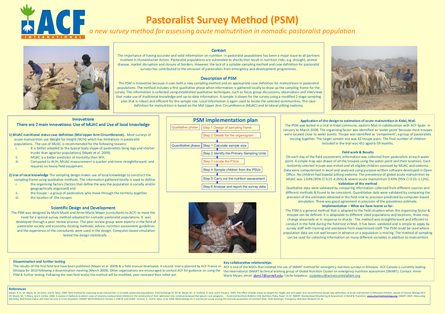
Context The importance of having accurate and valid information on nutrition in pastoralist populations has been a major issue to all partners involved in Humanitarian Action. Pastoralist populations are vulnerable to shocks that result in nutrition risks, e.g. drought, animal disease, market disruption and closure of borders. However, the lack of a suitable sampling method and case definition for pastoralist surveys has contributed to the omission of pastoralists from emergency and development programmes. Description of PSM The PSM is innovative because it uses both a new sampling method and an appropriate case definition for malnutrition in pastoralist populations. The method includes a first qualitative phase when information is gathered locally to draw up the sampling frame for the survey. This information is collected using established qualitative techniques, such as focus group discussions, observation and interviews that make use of traditional knowledge and up-to-date information. A sample is drawn for the survey using a modified 2 stage sampling plan that is robust and efficient for the sample size. Local information is again used to locate the selected communities. The case- definition for malnutrition is based on the Mid Upper Arm Circumference (MUAC) and bi-lateral pitting oedema. ?